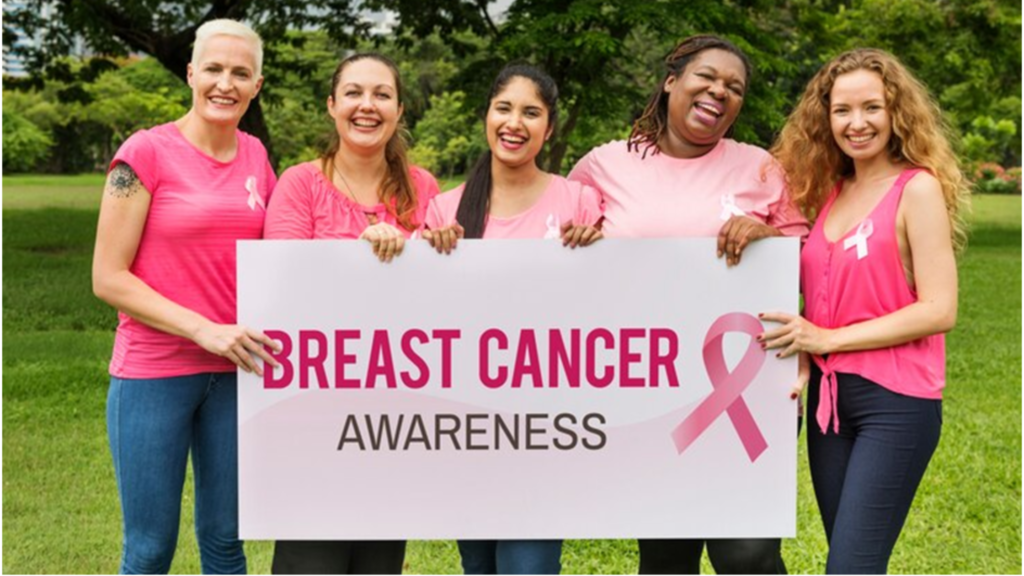
Breast Cancer Awareness Month – October is dedicated to raising awareness about one of the most prevalent and potentially life-threatening diseases affecting women worldwide.
“It is estimated that in 2023, approximately 297,790 women will be diagnosed with invasive breast cancer, in addition to 55,720 new cases of ductal carcinoma in situ (DCIS).”
Despite the high incidence, there is positive news. Early detection and treatment can significantly enhance survival rates. That is why Breast Cancer Awareness Month holds such importance. Throughout October, our focus is on raising awareness about breast cancer and the significance of early detection. To fully grasp the importance of this month, it is crucial to delve into the fundamentals of cancer, specifically breast cancer. This blog’s main motto is to provide a comprehensive overview of breast cancer, encompassing its causes, symptoms, and the significance of early detection.

What is Cancer?
Cancer occurs due to gene mutations that regulate cell growth, allowing cells to divide and multiply uncontrollably. This uncontrolled cell division leads to the formation of tumors, which can invade nearby tissues and spread to other parts of the body. The mutations in these genes can be inherited from parents or acquired during a person’s lifetime due to various factors such as exposure to carcinogens, radiation, or certain viruses. Additionally, certain lifestyle choices like tobacco use, lack of physical activity, unhealthy diet, and excessive alcohol consumption can enhance the chances of developing cancer.
Book a free Consultation
Get help from an experienced Business Consultant. Schedule yourconsultation at a time that works for you and it's absolutely FREE.
What is Breast Cancer?
Breast cancer is another form of cancer that begins in the breast cells. It commonly originates in the lobules, which are the milk-producing glands, or the ducts, which are the milk transport pathways to the nipple. Also, breast cancer may develop in the breast’s fatty tissue or fibrous connective tissue. As cancer cells proliferate without restraint, they can invade surrounding healthy breast tissue and potentially metastasize to the lymph nodes situated under the arms. These lymph nodes serve as crucial conduits for cancer cells to spread to other body areas.
Risk Factors for Breast Cancer
There are a number of risk factors for breast cancer, including:
● Sex: Breast cancer is more common in women than in men.
● Age: The likelihood of developing breast cancer increases as a person ages.
● Family history: Having a close family member with breast cancer can raise the risk.
● Certain genetic mutations: Some gene mutations can increase your risk of breast cancer.
● Dense breasts: Dense breasts have a maximum risk of breast cancer due to their higher amount of connective tissue and lower amount of fatty tissue compared to less dense breasts.
● Early menstruation: Starting menstruation before age 12 increases your risk of breast cancer.
● Late menopause: Starting menopause after the age of 55 increases your risk of breast cancer.
● Certain lifestyle factors: Obesity, alcohol consumption, and lack of exercise can increase your risk of breast cancer.
Common Symptoms of Breast Cancer

Detecting breast cancer in its early stages greatly enhances the likelihood of successful treatment. Hence, it is essential to be mindful of the typical symptoms linked to breast cancer. These symptoms may comprise:
Breast Lump or Tissue Thickening: A newly formed lump or thickening in the breast that feels unusual compared to the surrounding tissue.
Breast Pain: Breast discomfort or pain.
Skin Abnormalities: Red, pitted skin over the entire breast or peeling, scaling, or flaking of skin on the nipple or breast.
Breast Swelling: Swelling in all or part of the breast.
Nipple Abnormalities: Changes in the nipple, such as inversion or discharge other than breast milk.
Unexplained Changes in Breast Appearance: A sudden and unexplained change in the shape or size of the breast.
Lump or Swelling under the Arm: Presence of a lump or swelling under the arm, near the lymph nodes.
It is important to note that having any of these symptoms does not automatically mean that you have breast cancer. However, if you notice any of these symptoms, you must consult your doctor for a thorough examination and, if necessary, additional tests.
What are the ways to get involved in Breast Cancer Awareness Month?

There are many ways to get involved in Breast Cancer Awareness Month. You can:
● Consider donating to an organization that conducts research or supports those affected by breast cancer.
● Participate in a breast cancer awareness event, such as a webinar, NGO events, etc.
● Have a conversation with your loved ones about the importance of early breast cancer detection.
● Get screened for breast cancer if you are due for a mammogram.
By getting involved in Breast Cancer Awareness Month, you can help to raise awareness of this disease and save lives.
Bottom Lines!
Breast cancer is a worldwide disease affecting millions of women, making awareness and early detection paramount. By understanding the basics of breast cancer and being aware of the common symptoms, individuals can take proactive steps to protect their health. Breast Cancer Awareness Month – October serves as a reminder to educate ourselves and those around us, emphasizing the significance of regular screenings and promoting early intervention, which can significantly improve the chances of successful treatment and survival.




